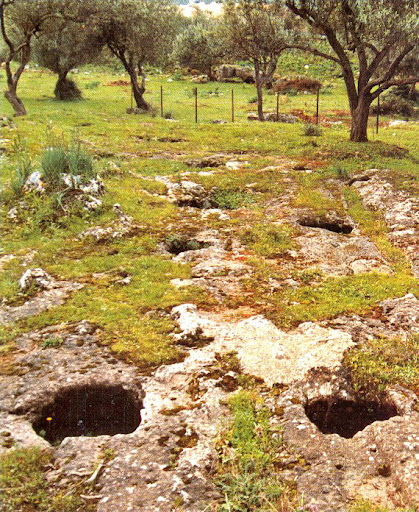Contrada Fondo Pozzo necropolis
Purely indicative georeferencing.
The first human settlements are evidenced by the discovery of two necropolises: the first in Contrada Ciachea (Carini), in an archaeological area very close to Capaci, the other in Capaci in the Fondo Pozzo district. This is located in a flat area between the inhabited center and the sea and has been affected in the past by occasional discoveries of small tombs which have aroused great interest above all for the shape of the niches which demonstrate a particular way of proceeding with burials. It has been noted, in fact, that the rock in which the tombs are excavated is marked by canals and wells that could suggest the practice of funerary sacrifices. The finds from this site consist mainly of brown pottery decorated with simple bands of white lines. The location of the necropolis of Contrada Ciachea, dating back to the Bronze Age, was, however, already known since its discovery in 1877 by Prof. Antonio Salinas (1841-1914), Director of the Archaeological Museum of Palermo, and the material found proved to be of considerable interest. More recent researches (1969), promoted by the Superintendence of Antiquities of Palermo and conducted by Dr. Flaminia Quojani of the Institute of Paleontology of the University of Rome, involved an area of 250 square meters. and led to the discovery of another 16 tombs, 2 of which have a double cell. Of the tombs explored 5 were still intact with the entrance space closed by a slab that had cemented itself to the walls of the well, sealing its contents. Deposited in the whitish and dusty soil of the cell, the skeletal remains of many individuals were discovered, together with various items of equipment: a total of 23 clay vases (ollette, mugs, bowls and amphorae), made of brown ceramic decorated with simple bands of white lines and in all similar to those discovered occasionally in the tombs of Fondo Pozzo. Furthermore, components of a necklace made with wild boar tusks and numerous flint blades were found. Particular interest was aroused by the burial of a child with the apparent age of ten, placed in a cell structurally different from the others, probably testifying to a position of pre-eminence in the family and social sphere. The extraordinary care reserved for burials excavated in the hypogean "chamber" in the limestone rocks (about two or three meters deep and accessible through ladders carved into the same rock) and the funerary equipment placed next to the deceased (from personal objects to numerous amulets) together a bowls containing food and drink constitute a profound attestation of worship and respect and testify to an intense belief in life after death. Part of the finds from this necropolis together with a great deal of material of scientific interest, including some wall engravings and a tomb completely removed from it, are on display at the Archaeological Museum of Palermo or kept in its deposits awaiting study and cataloging. (Source of the text: http://www.capaci.info/07archeologia/TerrArcheo.htm ) Site subject to archaeological restrictions
In-depth documents:
Giovanni Mannino: Guide to the Prehistory of Palermo - List of prehistoric sites in the province of Palermo - Sicilian Institute for Political and Economic Studies - 2008 - Publication produced with the contribution of the Regional Cultural Heritage Department,
Environmental and Public Education. Download the document: Guide-Prehistory-of-Palermo_10c8pt2p
Municipality of Capaci - General Town Plan - List of cards of buildings and artifacts to be protected. Download file: listof factories and manufactures
Card insertion: Ignazio Caloggero
Photo: http://www.capaci.info/07archeologia/TerrArcheo.htm
Information contributions: Ignazio Caloggero Web
PRESS: Well cataloged but partially geolocated. We invite you to provide your contribution by providing us with useful information that will allow us to geolocate the listed asset. See also "Cultural Heritage to be Geolocated"
Note: The populating of the files of the Heritage database proceeds in incremental phases: cataloging, georeferencing, insertion of information and images. The cultural property in question has been cataloged, georeferenced and the first information entered. In order to enrich the information content, further contributions are welcome, if you wish you can contribute through our area "Your Contributions"



